Sometimes I like to time travel through my nose.
Wait, what? Let me try that again.
You know when a familiar fragrance transports you back into a fond memory? That. That’s what I like.
I grew up in North Carolina. Every October, just as my birthday began to creep around the corner, the annual state fair set up shop downtown.
My dad would cart me and my awkward crew of middle schoolers all the way to the crowded fairgrounds, then return several hours later when we were so jammed with deep-fried cookies and lemonade—we couldn’t bear another game of ring toss. Though my friends adored the whirling rollercoasters and dizzying teacups, I was there for one reason, and one reason alone.
The food.
I didn’t come into my own as a professional cook until my late twenties, but I still grew up in a meal-obsessed home with culinary-consumed parents where herb-roasted Cornish hens draped in Julia Child’s buttery bearnaise sauce were the norm.
…That’s a normal dinner for a kid, right?
Needless to say, an infatuation with textures, traces, and flavors of food from all over the spectrum was built into my genes.
When I close my eyes and think back on those chilly fall days at the North Carolina State Fair—I can still smell the sweet, charred scent of Vidalia onions caramelizing on a shiny flat top. I can still feel the wispy blue-raspberry cotton candy melting onto on my tongue. And I can still see the golden, cornmeal-crusted corndogs on sticks people waved around like mustard-splattered torches.
But most of all, I can still taste the elephant ears.
Are you wondering how I just got from carnival eats to elephants?
If so, you’re probably not familiar with this nostalgic treat that’s most often associated with state fairs. Maybe you’ve heard of it called a funnel cake? That’s a bit different. Where a funnel cake is made by squeezing long stringy lines of liquid batter into a fryer to produce crispy tendrils—an elephant ear is created by dropping a flattened ball of elastic dough into a pool of hot oil.
Funnel cakes are delicately sprinkled in a blanket of powdered sugar and elephant ears are scattered in a sparkly shower of cinnamon-sugar or drizzled with sticky honey and a squeeze of lemon.
Clearly, neither one is a bad choice.
So how do we get from elephants and funnels to fry bread?
In this recipe, I steal elements from the aforementioned carnival foods, intertwine them with a divinely delicious staple from the Navajo tradition, give everything a boost—and then encourage the final product to go off into the world and live its best life.
That goes for you, too.
Now let’s get down to fry bread.
When it comes to the essentials of a Native American dinner table, this puffy round is always a regular guest. For a little more insight into the fry bread’s history (and a savory spin layered with spicy chicken and a tangy green salsa so good it will blow the socks off any buffalo wings you’ve ever had), you’ll want to go here.
The version we’re covering today is a sweet tooth’s dream-come-true. I amp up the base with a little sugar, top the freshly-fried oval with a citrusy sauce, and the end result smells as comforting as what you’d get on a greasy paper plate at the fair, but tastes so fancy that the queen wouldn’t even take off her gloves to eat it.
I believe that a colossal contrast of taste sensations is what makes an ingredient memorable, and lemon curd is at the top of that list. Known for being a “dessert spread,” this topping is typically made with citrus—giving it a tartness so profound it could curl your toes.
It’s silky and intense in the best possible way. And for a touch of floral elegance (that makes it something you will most definitely never find next to a corndog stand), I add the soothing flavor of lavender.
There’s a harmony between the fluffy, cinnamon-dusted fry bread and velvety lavender-lemon curd that simply can’t be explained through words.
I guess you’ll just have to try it out for yourself.

Cinnamon-Sugar Fry Bread with Lavender-Lemon Curd
In this vibrant dessert-style snack, handmade fry bread is cooked until golden-brown, sprinkled with nutty cinnamon-sugar, and drizzled with (or dunked in) tart lemon curd spiked with lavender. Each warm, crispy bite will transport you straight to your happy place. Keep reading for the recipe.
Ingredients
- 1 cup all-purpose flour, plus additional for dusting and rolling out the dough
- 2 teaspoons baking powder
- 1/2 teaspoon salt
- 10 tablespoons granulated sugar, divided
- 6 tablespoons unsalted butter, melted, divided
- 1 cup warm water
- 1 tablespoon ground cinnamon
- Juice of 2 large lemons (about 1/2 cup)
- 1 1/2 teaspoons chopped fresh lavender (or 1/2 teaspoon dried)
- 2 large egg yolks
- Vegetable oil (for frying, enough to reach 1 or 2-inch depth)
Instructions
Step 1 Make and Rest the Fry Bread Dough
Melt the butter.
In the bowl of a stand mixer fitted with the dough hook attachment (or in a large bowl if you’re preparing the dough by hand), add the flour, baking powder, salt, and 1 tablespoon of the sugar and mix on low speed to combine.
Slowly pour in 2 tablespoons of the butter until the dough holds together, and then add the water, a few tablespoons at a time, until the dough forms a moist ball, about 1-2 minutes. You may only need about 3/4 cup of the water.
Cover the dough with plastic wrap and rest at room temperature for at least 30 minutes or at best, 1 hour.
While the dough is resting, prepare the cinnamon-sugar and lavender-lemon curd.
Step 2 – Prepare the Toppings
In a small bowl, whisk 4 tablespoons of the sugar with the cinnamon until thoroughly mixed. Set aside.
Juice the lemons and chop the lavender (if you’re using fresh). If you’re using dried, delicately crush the lavender between your palms to release its oils.
In a small heavy-bottomed saucepan over medium heat, whisk the remaining 5 tablespoons of sugar, lemon juice, and lavender until the sugar has dissolved. Turn off the heat and allow the mixture to steep for at least 30 minutes.
Strain out the lavender, and return the mixture to the pan over low heat. Melt in the remaining 4 tablespoons of the butter and then remove the pan from heat. You can also use a double-boiler to make sure the curd doesn’t get too hot.
Delicately add in the egg yolks, taking the pan on and off heat to make sure you don’t scramble the eggs, and whisk frequently, until the curd has thickened, about 10 minutes. Cool the lavender-lemon curd to room temperature and then refrigerate until you’re ready to use.
Step 3 – Divide and Flatten the Dough
Lightly flour a clean work surface. Unwrap the dough and divide it into 4 even pieces. Roll each piece into a ball and then, using the palm of your hand (and adding more flour if necessary), stretch and flatten into 1/4-inch thick rounds. The breads will puff up as they cook (and don’t need to handle tons of toppings) so you want them to be fairly thin.
Pierce the center of each fry bread with a paring knife. This keeps the dough from over-bubbling during frying.
Step 4 – Fry the Dough
In a deep, wide cast iron skillet or heavy-bottomed saucepan over medium-high heat, heat about 1-2 inches of oil to approximately 350-375°F.
If you don’t have a thermometer, you can test if the oil is hot enough by dipping the handle of a wooden spoon into it. If it bubbles steadily, the oil is hot enough. If it bubbles and sizzles vigorously, the oil is too hot.
Prepare a paper towel-lined plate next to the pan with the oil. Working in batches so you don’t crowd the pan, slide the dough rounds into the oil and fry until golden-brown, about 1-2 minutes per side. The dough will puff up and harden as it cooks.
Step 5 –Garnish and Serve
Place the freshly fried breads on the paper towel-lined plate to drain off any excess oil and immediately sprinkle with the cinnamon-sugar.
Serve warm with the lavender-lemon curd by either drizzling it over the top or serving it alongside.
Notes
In the bowl of a stand mixer fitted with the dough hook attachment (or in a large bowl if you’re preparing the dough by hand), add the flour, baking powder, salt, and 1 tablespoon of the sugar and mix on low speed to combine.
Slowly pour in 2 tablespoons of the butter until the dough holds together, and then add the water, a few tablespoons at a time, until the dough forms a moist ball, about 1-2 minutes. You may only need about 3/4 cup of the water.
Cover the dough with plastic wrap and rest at room temperature for at least 30 minutes or at best, 1 hour.
While the dough is resting, prepare the cinnamon-sugar and lavender-lemon curd.
In a small bowl, whisk 4 tablespoons of the sugar with the cinnamon until thoroughly mixed. Set aside.
In a small heavy-bottomed saucepan over medium heat, whisk the remaining 5 tablespoons of sugar, lemon juice, and lavender until the sugar has dissolved. Turn off the heat and allow the mixture to steep for at least 30 minutes.
Strain out the lavender, and return the mixture to the pan over low heat. Melt in the remaining 4 tablespoons of the butter and then remove the pan from heat. Delicately add in the egg yolks, taking the pan on and off heat to make sure you don’t scramble the eggs, and whisk frequently, until the curd has thickened, about 10 minutes. Cool the lavender-lemon curd to room temperature and then refrigerate until you’re ready to use.
Lightly flour a clean work surface. Unwrap the dough and divide it into 4 even pieces. Roll each piece into a ball and then, one at a time, stretch and roll the dough into 1/4-inch thick rounds. Pierce the center of each piece several times with a paring knife (this keeps the dough from over-bubbling during frying).
In a deep, wide cast iron skillet or heavy-bottomed saucepan over medium-high heat, heat about 1-2 inches of oil to approximately 350-375° F.
If you don’t have a thermometer, you can test if the oil is hot enough by dipping the handle of a wooden spoon into it. If it bubbles steadily, the oil is hot enough. If it bubbles and sizzles vigorously, the oil is too hot.
Prepare a paper towel-lined plate next to the pan with the oil. Working in batches so you don’t crowd the pan, slide the dough rounds into the oil and fry until golden-brown, about 1-2 minutes per side.
Place the freshly fried breads on the paper towel-lined plate to drain off any excess oil and immediately sprinkle with the cinnamon-sugar.
Serve warm with the lavender-lemon curd.

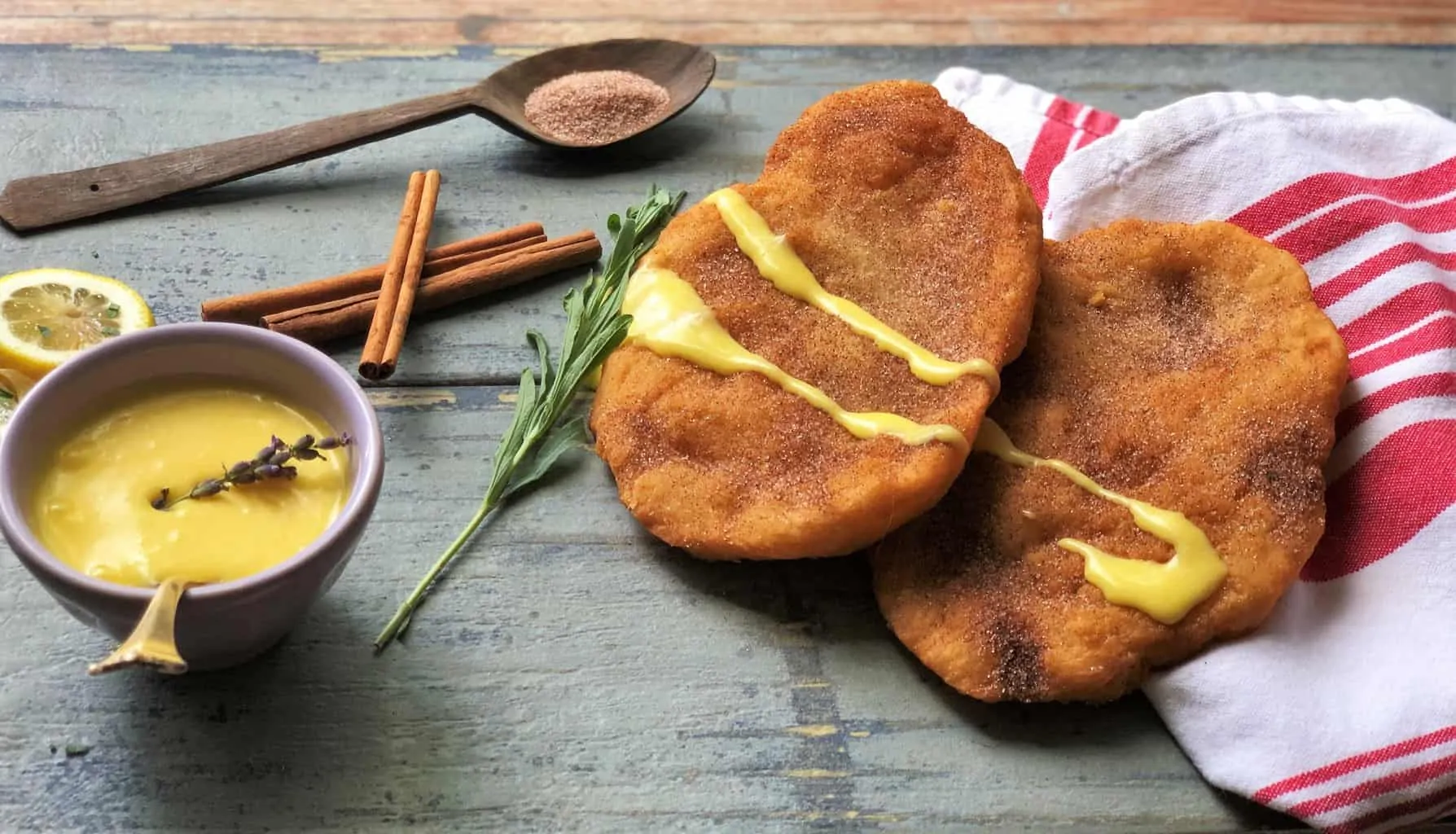
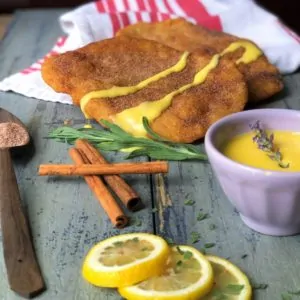




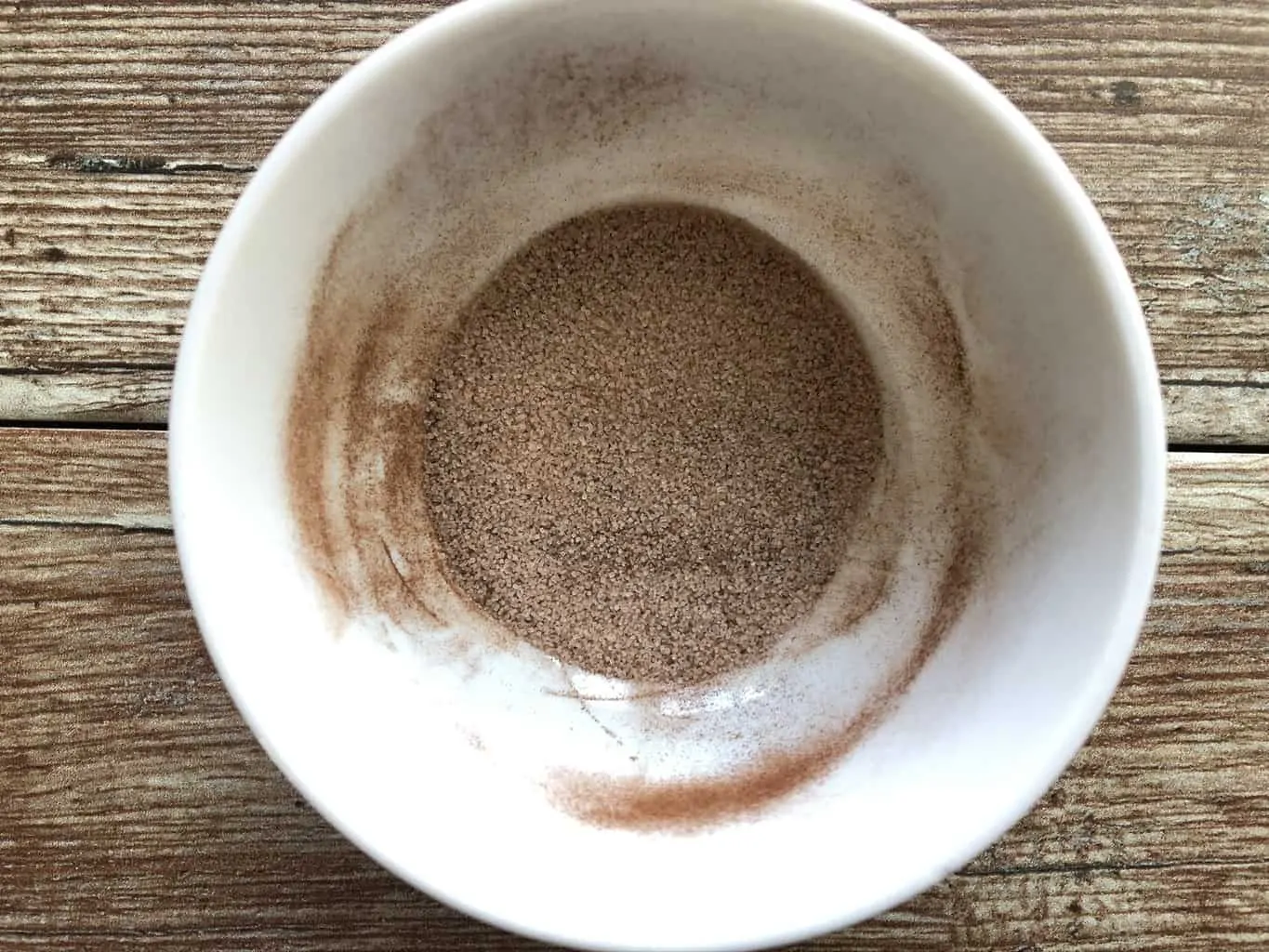

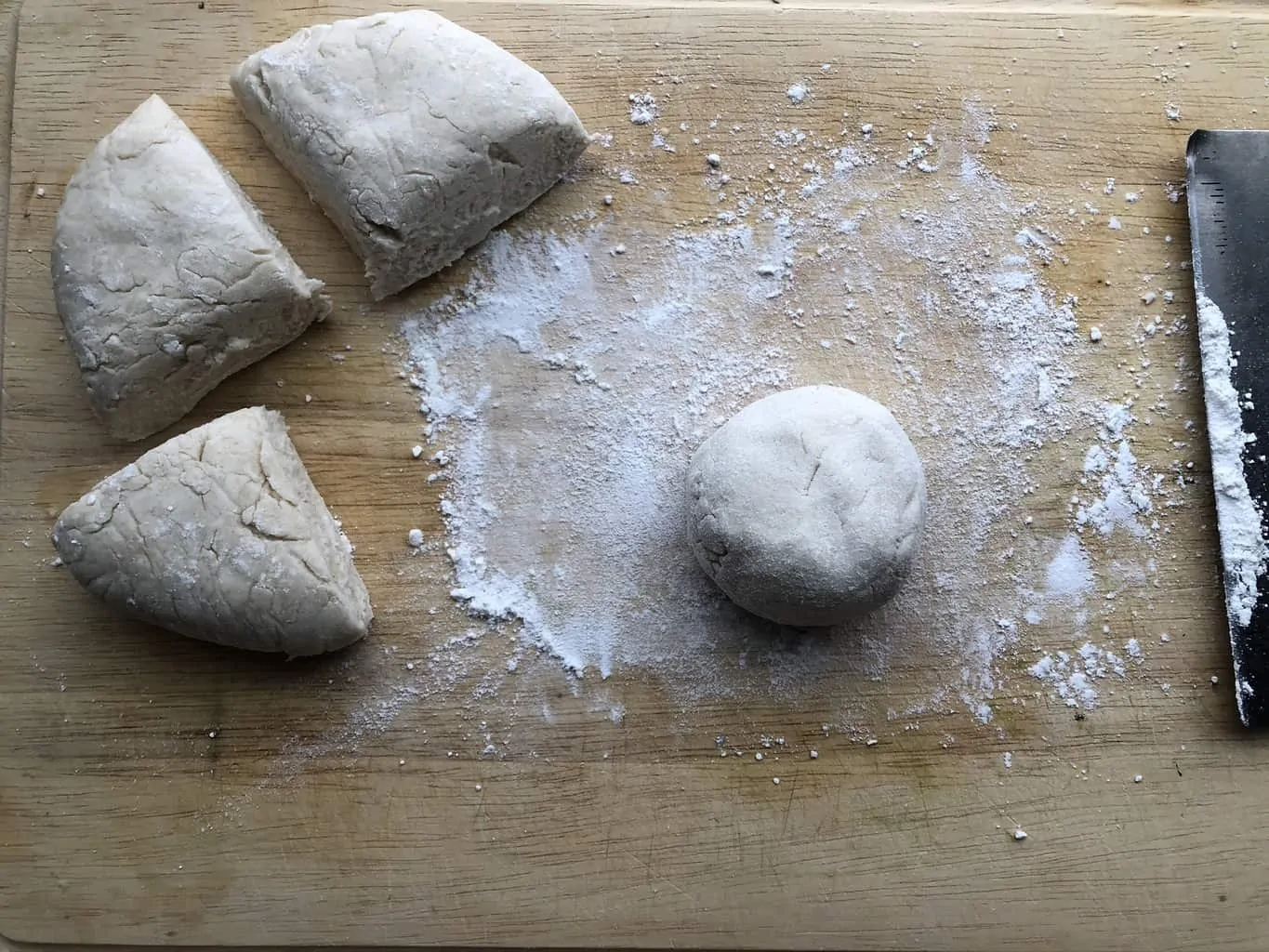

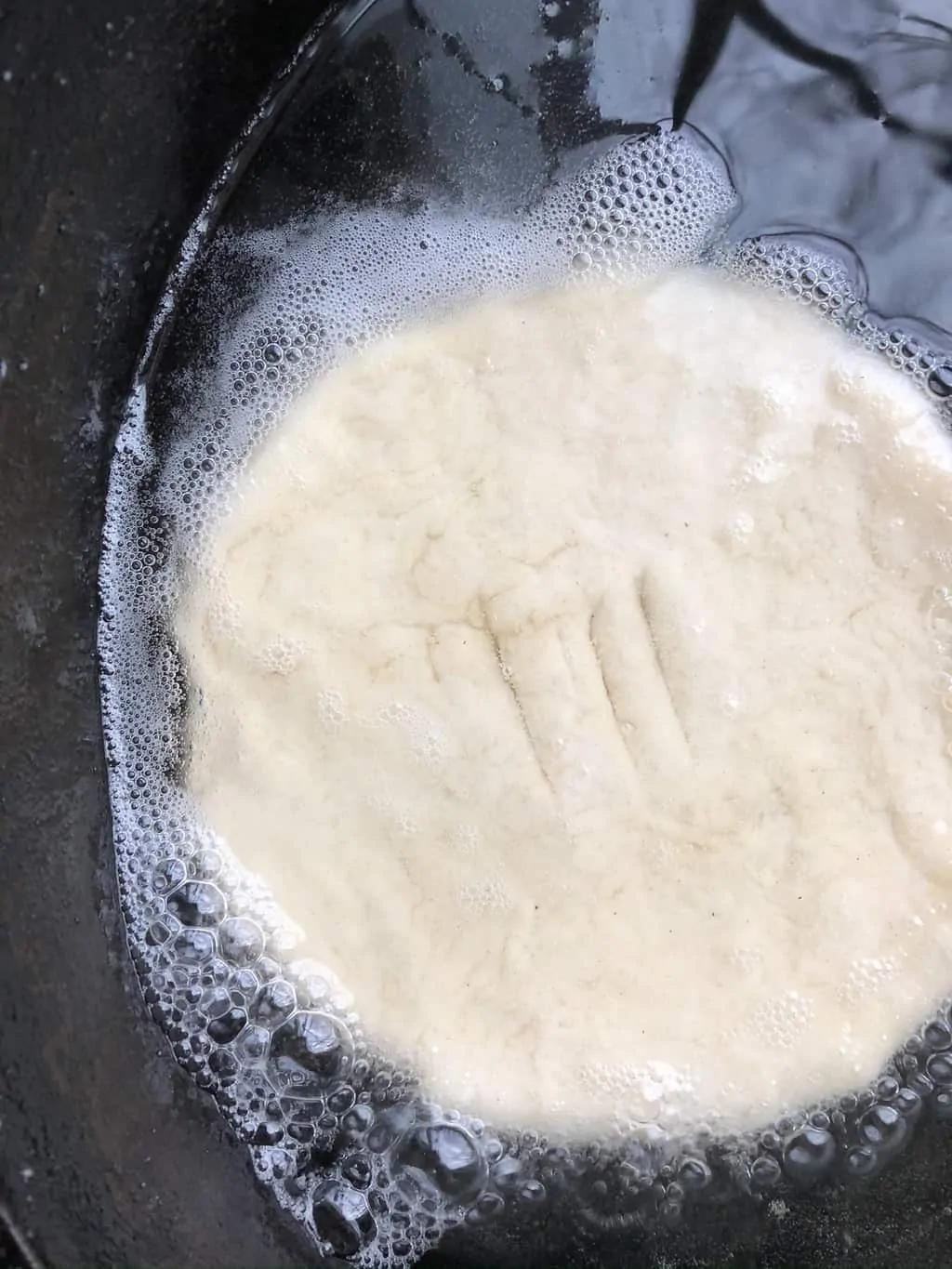
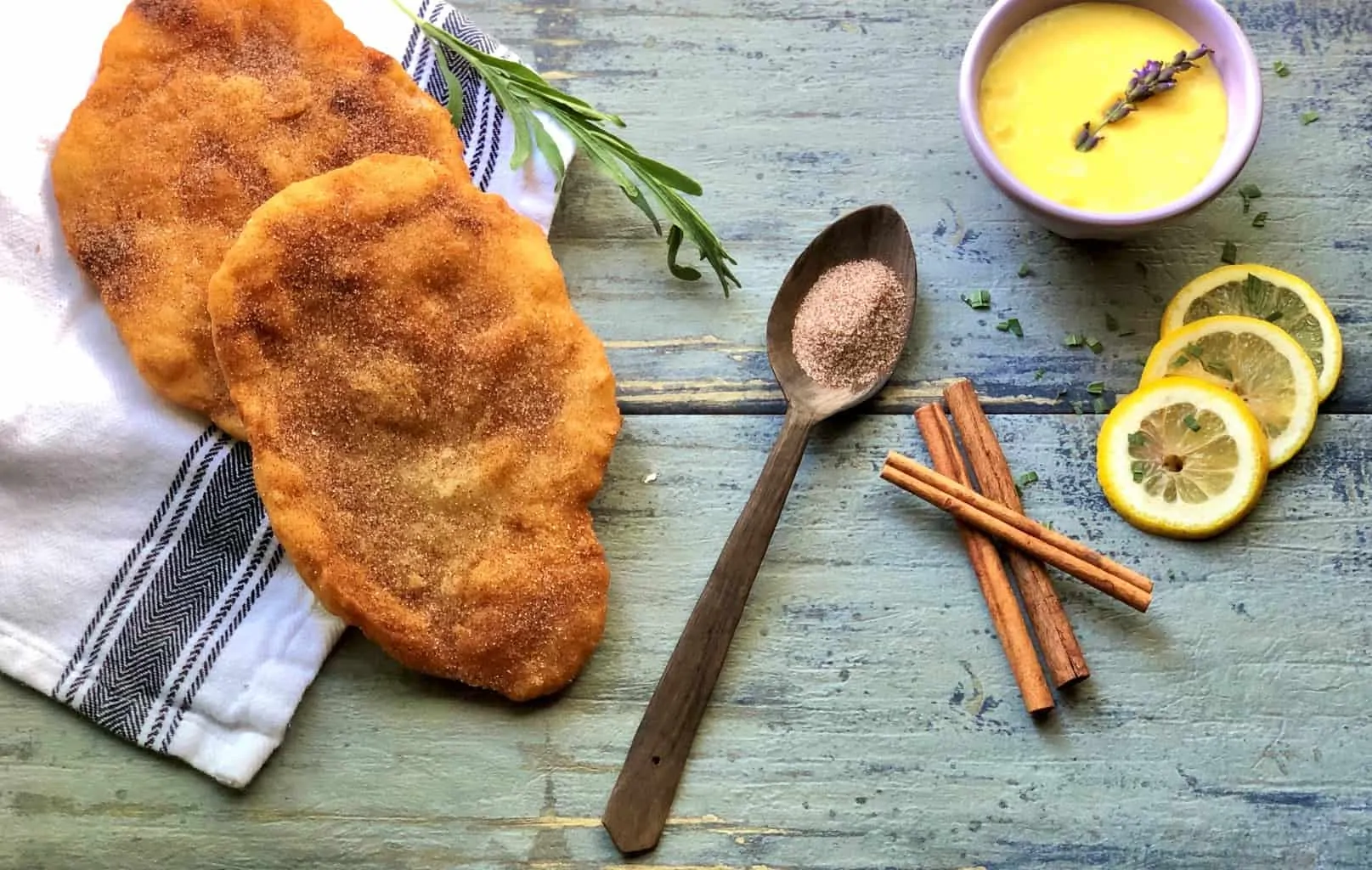


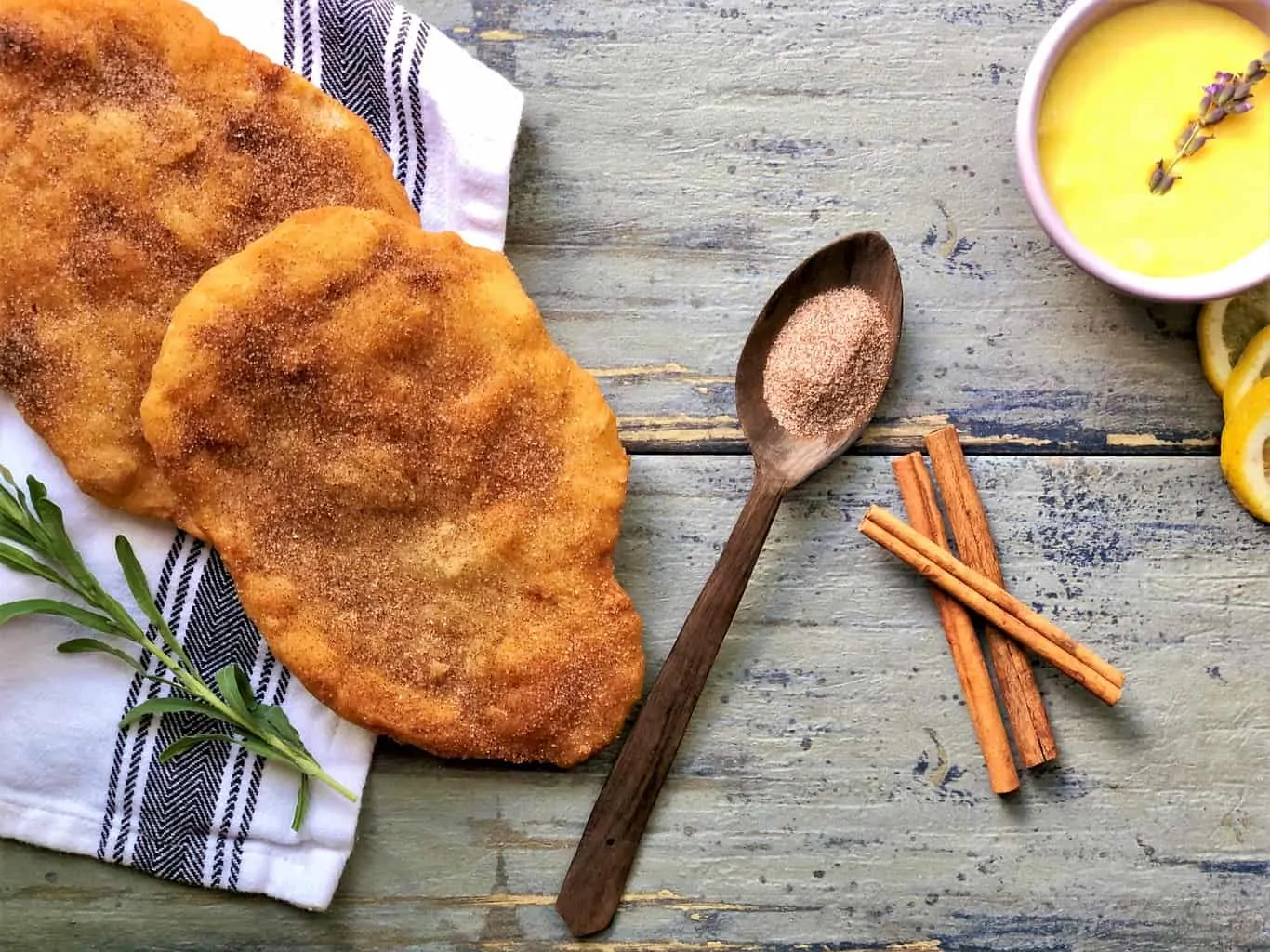




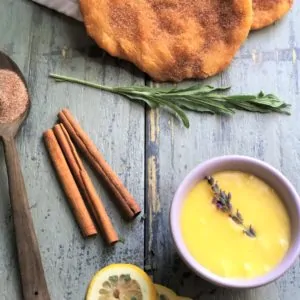

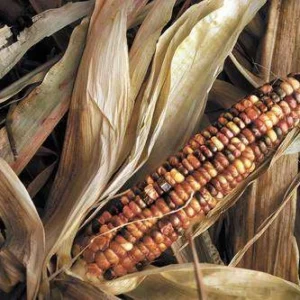

Denise Underwokd
says:What a mouth watering recipe, yummy!
Annie M.
says:Thanks! It’s wonderful to find that you’re a chef. This recipe makes me miss New Mexico. Wishing this pandemic was over. Nobody to share food with.
A green chile stew recipe, perhaps, à la The Frontier Restaurant in Albuquerque?
Hungry.
Running Doe
says:osiyo love my fry bread and know I would love this wado for sharing Running Doe